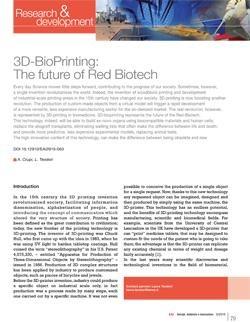Every day Science moves little steps forward, contributing to the progress of our society. Sometimes, however, a single invention revolutionizes the world. Indeed, the invention of woodblock printing and development of industrial-scale printing-press in the 15th century have changed our society. 3D-printing is now boosting another revolution. The production of custom-made objects from a virtual model will trigger a rapid development of a more versatile, less expensive manufacturing sector for the on-demand market. The real revolution, however, is represented by 3D-printing in biomedicine. 3D-bioprinting represents the future of the Red-Biotech. This technology, indeed, will be able to build ex-novo organs using biocompatible materials and human cells; replace the allograft transplants, eliminating waiting lists that often make the difference between life and death; and provide more predictive, less expensive experimental models, replacing animal tests. The high innovation content of this technology, can make the difference between being obsolete and new
3D-BioPrinting: il futuro del Red Biotech
Scienza e tecnologia fanno ogni giorno dei piccoli passi in avanti che insieme contribuiscono al progresso della società, ma talvolta una sola invenzione può rivoluzionare la storia. Così come l’invenzione della stampa nel XV secolo ha profondamente cambiato la nostra società, oggi, come allora, l’invenzione della stampa in 3D può rivoluzionare la Scienza/Tecnologia. La produzione di oggetti personalizzati, a partire da un modello virtuale, è in grado di rendere più versatile e meno costoso il settore manifatturiero, ma la vera rivoluzione è rappresentata proprio dall’impatto che la stampa 3D ha in campo bio-medico. Il 3D-BioPrinting, un settore emergente in campo biotecnologico, rappresenta il futuro delle RedBiotech. Con questa tecnologia sarà possibile costruire organi ex-novo partendo da materie prime bio-compatibili e da cellule umane, che sostituiranno i trapianti eterologhi, eliminando le liste d’attesa che spesso fanno la differenza tra la vita e la morte, e l’utilizzo di animali per i test clinici, fornendo modelli sperimentali più predittivi e meno costosi
Annunziata Crupi - ENEA, Nuclear Fusion and Safety Technologies Department, Frascati Research Centre (Visiting Researcher at ENEA, Frascati Research Centre)
Laura Teodori - Fondazione San Raffaele, Ceglie Messapica (Chair of the Indo-Italian Biomaterials and Tissue Engineering Forum, www.i2bite.com)


